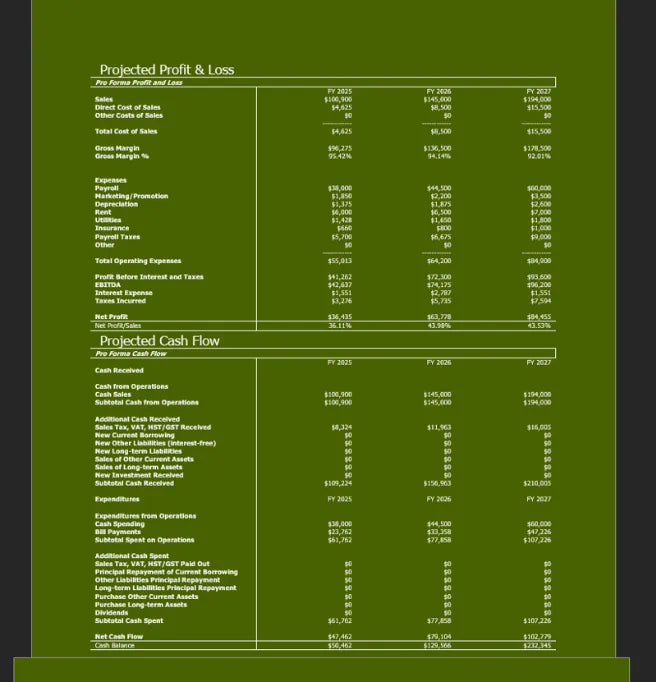
Mobile & Seasonal Business Plan Hub (U.S., 2025)
A single hub that ties together hot dog carts, shaved ice, cotton candy, hunting & fishing sh...
Read More →





Worried about startup costs, lender approval, or proving your restoration shop can be profitable? This SBA-aligned plan shows exactly how your labor, parts, and timelines translate into a credible, fundable business. It ships in fully editable Word & PDF with a detailed 3-year financial forecast—so you can present a professional, funding-ready case fast.
Built for classic restorers, hot-rod builders, custom body shops, and performance garages. Whether you’re staging frame-off rebuilds, metal and paint, interiors, or concours-level projects, you’ll model labor calendars, parts sourcing, deposits and draws, booth utilization, and quality controls—so lenders and landlords see a shop that runs on process, not hope.
BPlanMaker promise: buy once, edit forever—no subscriptions. Instant download, U.S.-focused structure, and a clear path to “yes” from reviewers.
A lender-ready, U.S.-specific business plan for restoration shops that details services (frame-off, paint, interiors, fabrication), pricing logic, project timelines, parts sourcing, staffing, safety, and quality control—plus a 3-year forecast. It shows how deposits, progress draws, and work-in-process translate into cash flow; how booth and bay utilization supports revenue targets; and how supplier terms affect margins. Customize labor rates, calendars, materials, and marketing to match your shop. Delivered in Word & PDF, it’s designed to satisfy bank reviewers while giving you a day-one operating playbook.
Auto restoration revenue is driven by skilled labor hours, materials, and reputation. Capacity hinges on booth/bay utilization and reliable sourcing for OEM/NOS or quality aftermarket parts. Positioning as a schedule-driven, milestone-paid shop reduces idle time and protects cash flow. Classification commonly aligns with NAICS 811121 (Automotive body, paint, interior, and glass repair). For authoritative safety/ventilation guidance on spray finishing and booths, see OSHA Standard 29 CFR 1910.107.
Generic templates miss realities like multi-month work-in-process, deposit schedules, and reassembly risks. This plan doesn’t. It models labor calendars, materials, booth hours, supplier terms, and contingency buffers—so lenders can follow the logic from estimate to delivery. Edit rates, calendars, vendor terms, and galleries in minutes. Reviewers find the right sections fast, which cuts back-and-forth and speeds decisions.
1) Executive Summary. Summarizes the restoration concept, target vehicle eras, service mix, and funding request. It highlights your differentiation (craft, turnaround, concours standards) and establishes revenue targets tied to realistic bay and booth utilization. A crisp summary signals professionalism and sets the terms for lender review.
2) Company Description. Defines ownership, legal structure, location, and shop footprint. It clarifies compliance (paint booth ventilation, waste handling) and shows how your facility supports throughput. Include visuals or links to prior builds to demonstrate credibility and the depth of your craft.
3) Market Analysis. Quantifies regional demand (collectors, auction activity, private sellers) and maps competitors by specialty. Show pricing bands, waitlists, and where you win (metalwork, interiors, show-prep). Use this section to justify labor rates and timelines with evidence, not guesswork.
4) Organization & Management. Outlines the owner-builder role, lead techs, body/paint specialists, upholsterers, and admin. Clarify responsibilities for estimates, parts, QC, and customer updates. Cross-training and documented SOPs reduce rework and maintain quality during growth.
5) Services or Product Line. Details restoration tiers (driver, show, concours), change-order policy, and photo-verified milestones. Explain sourcing (OEM, NOS, reputable aftermarket) and how you warranty craft and paint. This is where lenders see how quality translates into repeatable revenue.
6) Marketing & Sales. Covers car shows, clubs, referral partners, before/after galleries, and YouTube build diaries. Set response-time SLAs and deposit workflow. Transparent timelines and photo updates build trust and reduce cancellations—key to stable cash flow.
7) Financial Projections. Presents a 3-year model with labor utilization, materials, overhead, deposit/draw timing, and breakeven. Scenario tabs (rush jobs, parts delays) help pressure-test cash. Tie assumptions to shop capacity so numbers feel inevitable—not optimistic.

A complete, editable plan for restoration shops that covers services, timelines, sourcing, staffing, and a 3-year forecast in an SBA-aligned structure (Word + PDF).
Yes—edit rates, materials, supplier terms, bay hours, deposits/draws, and galleries in minutes to reflect your shop.
It highlights use-of-funds, realistic assumptions, utilization, and risk controls—exactly what reviewers look for.
Immediately after checkout—download Word & PDF and start editing today.
Yes—update labor calendars, materials, overhead, and deposit/draw timing to project revenue, margins, and cash flow.
No. Buy once, edit forever. No recurring fees—ever.
Show lenders a plan that runs on craft and process—from estimate to delivery.
Last updated: November 11, 2025
BPlanMaker


Couldn't load pickup availability





Explore our latest articles on writing a stronger business plan, using your business plan template, and getting ready for lenders, investors, and SBA programs.

A single hub that ties together hot dog carts, shaved ice, cotton candy, hunting & fishing sh...
Read More →
U.S. 2025 guide to planning a shaved ice / snow cone business with the SBA-style layout lenders e...
Read More →
U.S. 2025 guide to planning a hunting & fishing shop with the SBA-style layout lenders expect...
Read More →